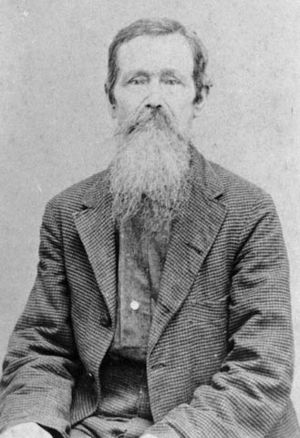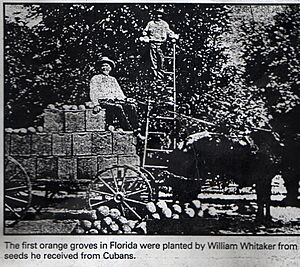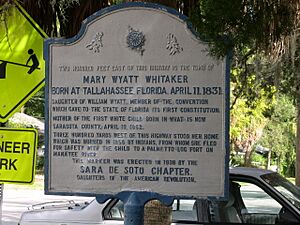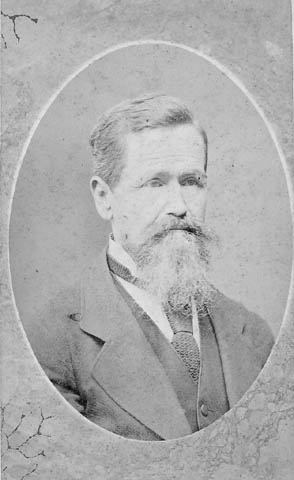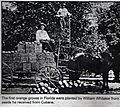William Whitaker (pioneer) facts for kids
William Henry Whitaker (1821–1888) was an American Seminole War veteran and pioneer. He was important for starting the first lasting settlement in what is now Sarasota, Florida.
William Whitaker used a special law called the Armed Occupation Act to claim land. He traded fish with Cuban people and brought the first orange trees to Florida. Later, he married Mary Jane Wyatt. They had twelve children, and their first child, Nancy, was the first recorded birth in what is now Sarasota County. William also helped a famous person, Judah P. Benjamin, escape to London after the Civil War.
Contents
William Whitaker's Early Life
William Whitaker was born in 1821 in Savannah, Georgia. His mother was Frances Snell, and his father was Richard Whitaker. When he was just twelve years old, he left home. He traveled to St. Marks, Florida, which was a busy seaport back then.
He worked in the fishing business there. He met his half-brother, Hamlin Valentine Snell, who later became a very important politician in Florida. Hamlin helped William get a good education in Tallahassee. While in Tallahassee, William met Mary Jane Wyatt, who would later become his wife.
In 1840, when he was nineteen, William joined Florida's Mounted Militia. He served for three months in the Second Seminole War. He was paid $70 for his service. After the war, William continued to work in fishing. He traveled along Florida's Gulf Coast and even went to Havana, Cuba.
Building a Home in Sarasota
The western coast of Florida did not have many permanent towns south of Gainesville. William Whitaker took advantage of the Armed Occupation Act. This law allowed him to get 160 acres of land and supplies. He just had to build a home and protect it for five years.
In December 1842, William and his half-brother sailed to what is now Yellow Bluffs in Sarasota Bay. They chose this spot because it was high ground. It also had fresh water springs and signs of old burial mounds. William built a simple log cabin there. He started fishing and farming.
He traded fish with Cuban traders for one penny per fish. He saved enough money to buy cattle in Dade City. From these same Cuban traders, he got oranges and guavas. He planted the first commercial citrus groves in Florida. Today, Florida grows 75% of the country's oranges. William even created his own type of orange, which he called the "Whitaker Sweet."
William also helped his community. He worked as a clerk for elections in Hillsborough County. Only six people were registered to vote there at the time. Later, he was elected to be the county sheriff. In 1847, two years after Florida became a state, William bought cattle. He used the number "47" as his brand for the cattle.
He survived two big hurricanes: the 1846 hurricane and the Great Gale of 1848. He called the 1848 storm "the granddaddy of all hurricanes." This hurricane created a new waterway through Longboat Key. William named it "New Pass," and it still has that name today.
In 1851, William married his sweetheart, Mary Jane Wyatt. She was a pioneer from a village called Manatee. Mary Jane moved to his cabin, and they started their family. Their marriage and the birth of their first child, Nancy Catherine Stuart Whitaker, were the first recorded in what is now Sarasota County. That same year, William bought more land from the state. This land is now part of modern-day Sarasota, stretching from Indian Beach Drive to Tenth Street. The path he made from Yellow Bluffs north became part of the Tamiami Trail in 1926.
Relationship with Seminole Indians
The Whitaker family was friendly with the local Indians and even helped escaped slaves. Once, they helped a famous Seminole chief named Billy Bowlegs. They brought him to their home and helped him recover from malaria. When William's wife asked the chief if he would ever harm her family, Bowlegs promised he would not.
However, this peaceful relationship changed in 1856. Billy Bowlegs became angry because United States troops destroyed his gardens. Soon after, the Indians attacked Braden Castle. The fighting increased. William took his family to a fort in Manatee County to keep them safe. He then traveled seventy miles to Peace Creek. This was the closest military base, and he went to tell them about the attack.
Not long after, the Whitaker home in Sarasota was burned down. A friend, George Owen, was inside and died. Many other homes were also destroyed. This conflict, known as the Billy Bowlegs War, lasted until 1858.
William Whitaker and the Civil War
After rebuilding their home, the Whitakers mostly stayed out of the American Civil War. Florida was one of the first states to leave the Union. The Union navy blocked goods from reaching the South. This made it hard for settlers to get supplies. Union troops also started moving inland from the Gulf of Mexico.
Because of the blockade, William had to make a difficult three to four-week trip to Gainesville. He went to buy grain for his community. William was one of three local people who had gristmills hidden deep in the woods. These mills were very important for grinding grain after Union troops destroyed the community's steam-powered mill.
As the war was ending, Judah P. Benjamin, who was a high-ranking official for the Confederacy, was being chased. He made his way to Florida's west coast. John Lesley of Tampa helped him get to the Sarasota area by boat. William Whitaker, his neighbor Captain John Tresca, and Benjamin planned how Benjamin could escape. Most boats had been destroyed or taken during the war. After two weeks, they found a small boat called a yawl and stocked it with supplies. Benjamin left from Whitaker Bayou. He safely reached Bimini and then Nassau. From there, he went to London and became a lawyer for the Queen.
Later Years and Legacy
In his later years, William Whitaker mostly stayed at his home. His wife had given birth to eleven children, and nine of them survived. After a long life on the frontier, William died in 1888 at age 67. He passed away from injuries after falling from his horse. Mary Jane died in 1909.
William and many of his family members are buried in the Whitaker Cemetery. This cemetery is on 12th Street next to Pioneer Park. The cemetery has a special marker dedicated by the Daughters of the American Revolution. This marker honors the family's important local history.
Today, most of William Whitaker's original land has been replaced by offices, homes, and apartments along the Sarasota coast. However, the inlet that ran through his family's land is still called Whitaker Bayou. Also, Whitaker Gateway Park exists to honor William and his family.
Images for kids


